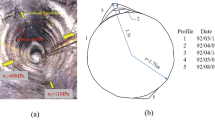Abstract
The application of the non-explosive expansion material (NEEM) is widely used as the controlled fracture method in quarry mining, especially in hard rocks. The pressure of NEEM is an important parameter in causing rock fracture. An empirical model based on hole spacing was developed to determine the pressure of NEEM in the rock fracture process. Primarily, the empirical model was developed by the mathematical method, utilizing dimensional analysis. Then, the Phase2 code, which is based on the finite element method, was utilized to predict crack growth in rocks. The results of numerical analysis show slight deviations from the empirical model. Hence, the polynomial regression analysis was used to modify the model. Finally, the modified model shows a good agreement with the results gained from numerical modeling.
Similar content being viewed by others
References
P.P. Roy, Rock Blasting: Effects and Operations, A.A. Balkema, Rotterdam, 2005, p.345.
Sh. Arshadnejad, Application of stress analysis and fracture mechanics in controlled blasting for hard rock quarry mining, [in] Proceeding of the 1st Symposium of Dimension Stone, Mahallat, 2007, p.10.
K. Goto, K. Kojima, and K. Watabe, The mechanism of expansive pressure and blow-out of static demolition agent, [in] Proceedings of Demolition and Reuse of Concrete and Masonry, Japan, 1988, p.132.
Z.Z. Jin, H. Liao, and W. Zhu, Splitting mechanism of rock and concrete under expansive pressure, [in] Proceedings of Demolition and Reuse of Concrete and Masonry, Japan, 1988, p.141.
S. Jana, Non-explosive expanding agent: an aid for reducing environmental pollution in mines, Indian Min. Eng. J., 1 (1991), p.31.
H. Hayashi, K. Soeda, T. Hida, and M. Kanbayashi, Non-explosive demolition agent in Japan, [in] Proceedings of Demolition and Reuse of Concrete, London, 1994, p.231.
E. Hoek and Z.T. Bieniawski, Brittle fracture propagation in rock under compression, Int. J. Fract. Mech., 1(1965), No.3, p.137.
E.Z. Lajtai, Effect of tensile stress gradient on brittle fracture initiation, Int. J. Rock Mech. Min. Sci., 9(1972), p.569.
B.R. Lawn and T.R. Wilshaw, Fracture of Brittle Solids, Cambridge University Press, Cambridge, 1975, p.274.
A.R. Ingraffea and R.A. Schmidt, Experimental verification of a fracture mechanics model for tensile strength prediction of Indiana limestone, [in] Proceedings of the 19th US Symposium on Rock Mechanics, Nevada-Reno, 1978, p.247.
R.J. Fowell, Suggested method for determining mode I fracture toughness using cracked chevron notched Brazilian disc (CCNBD) specimens, Int. J. Rock Mech. Min. Sci. Geomech. Abstr., 32(1995), No.1, p.57.
E. Eberhardt, B. Stimpson, and D. Stead, The influence of mineralogy on the initiation of microfractures in granite, [in] Proceedings of the 9th International Congress on Rock Mechanics, Paris, Rotterdam, 1999, p.1007.
B.G. Orekhov and M.G. Zertsalov, Fracture Mechanics of Engineering Structures and Rocks, A.A. Balkema, Rotterdam, 2001, p.285.
S. Yagiz, Assessment of brittleness using rock strength and density with punch penetration test, Tunnelling Underground Space Technol., 24(2009), p.66.
S. Arshadnejad, K. Goshtasbi, and J. Aghazadeh, Stress concentration analysis between two neighboring circular holes under internal pressure of a non-explosive expansion material, Earth Sci., 30(2009), No.3, p.259.
Y.S. Wang, B.K. You, and G.Q. Zhang, Application of soundless cracking agent in China, [in] Proceedings of Demolition and Reuse of Concrete and Masonry, Japan, 1988, p.149.
Fract AG Inc., Technical Report about its Productions, www.westernblasting.com/fractag.html, Update on 8 Jan 2008.
W.R. Powell, Studies of Fracture Mechanics of Coal, Technical Report, U.S. Department of Energy, 1980.
J.A. Huang and S.J. Wang, An experimental investigation concerning the comprehensive fracture toughness of some brittle rocks, Int. J. Rock Mech. Min. Sci., 22(1985), No.2, p.99.
R. John and S.P. Shah, Effect of high strength and rate of loading on fracture toughness of concrete, SEM/RILEM, [in] Proceedings on Fracture of Concrete and Rock, Houston, 1987, p.35.
K.L. Gunsallus and F.H. Kulhawy, A comparative evaluation of rock strength measures, J. Rock Mech. Min. Sci. Geomech. Abstr., 21(1984), No.5, p.233.
J.C. Swearengen, E.K. Beauchamp, and R.J. Eagan, Fracture toughness of reinforced glasses, [in] Proceedings of Fracture Mechanics of Ceramics, New York, 1978, p.973.
W.K. Kim, J.S. Soh, H.S. Kim, et al., The influences of additives and curing temperature on the expansion pressure of calcium oxide hydration, J. Korean Ceram. Soc., 44(2007), p.529.
K. Soeda, S. Yamada, Y. Nakashima, et al., Non-explosive demolition agent, [in] Proceedings of Demolition and Reuse of Concrete and Masonry, Japan, 1988, p.116.
Ch. Chatfield, Statistics for Technology: a Course in Applied Statistics, Chapman & Hall, London, 1983, p.381.
D.C. Montgomery, G.C. Runger, and N.F. Hubele, Engineering Statistics, John Wiley & Sons, Inc., New York, 2001, p.494.
Rocscience, Inc., Phase 2 Verification Manual, 1999.
Rocscience, Inc., Phase 2 Model Program Reference Manual, 2001.
Author information
Authors and Affiliations
Corresponding author
Rights and permissions
About this article
Cite this article
Arshadnejad, S., Goshtasbi, K. & Aghazadeh, J. A model to determine hole spacing in the rock fracture process by non-explosive expansion material. Int J Miner Metall Mater 18, 509–514 (2011). https://doi.org/10.1007/s12613-011-0470-5
Received:
Revised:
Accepted:
Published:
Issue Date:
DOI: https://doi.org/10.1007/s12613-011-0470-5




